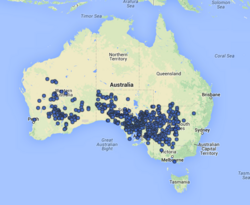Biology:Casuarina pauper
| Casuarina pauper | |
|---|---|

| |
| In Kinchega National Park | |
| Scientific classification | |
| Kingdom: | Plantae |
| Clade: | Tracheophytes |
| Clade: | Angiosperms |
| Clade: | Eudicots |
| Clade: | Rosids |
| Order: | Fagales |
| Family: | Casuarinaceae |
| Genus: | Casuarina |
| Species: | C. pauper
|
| Binomial name | |
| Casuarina pauper | |
| Synonyms[1] | |
| |
Casuarina pauper, commonly known as black oak, belah or kariku,[2] is a species of flowering plant in the family Casuarinaceae and is endemic to southern continental Australia. It is a dioecious tree with fissured or scaly bark, waxy branchlets, the leaves reduced to scales in whorls of 9 to 13, the fruit 13–18 mm (0.51–0.71 in) long containing winged seeds (samaras) 5.5–7.0 mm (0.22–0.28 in) long.
Description
Casuarina pauper is a dioecious tree similar to C. cristata, that typically grows to a height of 5–15 m (16–49 ft), has a DBH of up to 0.5 m (1 ft 8 in), and sometimes produces root suckers. The branchlets are more or less erect or spreading, up to 250 mm (9.8 in) long, the leaves reduced to scale-like teeth 0.8–0.9 mm (0.031–0.035 in) long, arranged in whorls of 9 to 13 around the branchlets. The sections of branchlet between the leaf whorls (the "articles") are waxy, 8–17 mm (0.31–0.67 in) long and 1.0–1.8 mm (0.039–0.071 in) wide. The flowers on male trees are arranged in spikes 10–30 mm (0.39–1.18 in) long, the anthers 0.8–1.1 mm (0.031–0.043 in) long. The female cones are covered with rusty hairs, on a peduncle 1–14 mm (0.039–0.551 in) long. The mature cones are usually 10–22 mm (0.39–0.87 in) long and 11–15 mm (0.43–0.59 in) in diameter, the samaras 5.5–7.0 mm (0.22–0.28 in) long.[2][3][4]
This species is a poorer, stunted form of C. cristata, and the two species often intergrade where their ranges overlap.[2]
Taxonomy
Casuarina pauper was first formally described in 1989 by Lawrie Johnson in the Flora of Australia from a Ferdinand von Mueller's unpublished description of a plant he collected in the Flinders Ranges in 1851.[5] The specific epithet (pauper) means "scanty" or "poor", referring to the habit of the species compared to C. cristata.[6]
Johnson had previously described Casuarina cristata subsp. pauper (Miq.) L.A.S.Johnson in the journal Nuytsia,[7] based Miquel's C. pauper, but the name was not valid, because Miquel explicity did not accept von Mueller's description of Casuarina pauper, considering it the same species as C. cristata.[8][9][10]
Distribution and habitat
Black oak grows in red-brown soils on open woodland, sometimes with Callitris gracilis, and is widespread across southern Australia, including in the far south-west of Queensland, western New South Wales, north-western Victoria, South Australia, and inland Western Australia.[2][3][4][11][12]
This species is generally found growing in groves ranging in area from less than 1 to 10 ha (2.5 to 24.7 acres) at altitudes from 400–500 m (1,300–1,600 ft), and where the temperature ranges between 3 and 36 °C (37 and 97 °F).[4][13]
Ecology
Casuarina pauper produces abundant viable seed, with regeneration success likely to be inhibited during periods of insufficient soil moisture. When present at low densities, plants tends to reproduce sexually, while established groves extend mostly from the fringes through root suckers, increasing the local area occupied by individual plants.[13][14]
References
- ↑ 1.0 1.1 "Casuarina pauper". Australian Plant Census. https://biodiversity.org.au/nsl/services/apc-format/display/56300.
- ↑ 2.0 2.1 2.2 2.3 Wilson, Karen L.; Johnson, Lawrence A.S.. "Casuarina pauper". Royal Botanic Garden Sydney. https://plantnet.rbgsyd.nsw.gov.au/cgi-bin/NSWfl.pl?page=nswfl&lvl=sp&name=Casuarina~pauper.
- ↑ 3.0 3.1 "Casuarina pauper". Australian Biological Resources Study, Department of Agriculture, Water and the Environment: Canberra. https://profiles.ala.org.au/opus/foa/profile/Casuarina%20pauper.
- ↑ 4.0 4.1 4.2 Boland, Douglas J.; Brooker, M. I. H.; Chippendale, G. M.; McDonald, Maurice William (2006). Forest trees of Australia. Collingwood, Victoria: CSIRO Publishing. pp. 78–79. ISBN 0-643-06969-0. https://books.google.com/books?id=q2v3kb9tFsYC&q=%22Casuarina+cristata%22&pg=PA78.
- ↑ "Casuarina pauper". APNI. https://id.biodiversity.org.au/instance/apni/8154820.
- ↑ Sharr, Francis Aubi; George, Alex (2019). Western Australian Plant Names and Their Meanings (3rd ed.). Kardinya, WA: Four Gables Press. p. 272. ISBN 9780958034180.
- ↑ Johnson, Lawrence A.S. (1972). "New species and subspecies of Casuarina in Western Australia". Nuytsia 1 (3): 265. https://www.biodiversitylibrary.org/item/223212#page/51/mode/1up. Retrieved 4 May 2023.
- ↑ "Casuarina cristata subsp. pauper". APNI. https://id.biodiversity.org.au/instance/apni/55746.
- ↑ Miquel, Friedrich A.W. (1859). "Stirpes Novo-Hollandas a Ferd Mullero collectas determinavit.". Nederlandsch kruidkundig archief 4 (1): 100–101. https://www.biodiversitylibrary.org/item/107019#page/140/mode/1up.
- ↑ Wilson, Karen L.; Johnson, Lawrence A.S. (1989). Flora of Australia. Canberra: Australian Government Publishing Service. pp. 110, 202. https://www.dcceew.gov.au/sites/default/files/env/pages/a08d125d-a6d0-47c4-85e9-9b7ac5d4931a/files/flora-australia-03-hamamelidales-casuarinales.pdf. Retrieved 4 May 2023.
- ↑ "Casuarina pauper Black oak". Botanic Gardens of South Australia. http://plantselector.botanicgardens.sa.gov.au/Plants/Details/2731.
- ↑ "Casuarina pauper - black oak". FloraBase. Western Australian Government Department of Parks and Wildlife. https://florabase.dpaw.wa.gov.au/browse/profile/12658.
- ↑ 13.0 13.1 Barritt, Andrew R.; Facelli, José M. (November 2001). "Effects of Casuarina pauper litter and grove soil on emergence and growth of understorey species in arid lands of South Australia". Journal of Arid Environments 49 (3): 569–579. doi:10.1006/jare.2001.0808.
- ↑ Auld, Tony D. (1995). "The Impact of Herbivores on Regeneration in Four Trees From Arid Australia". The Rangeland Journal 17 (2): 213–227. doi:10.1071/RJ9950213.
Wikidata ☰ Q3538354 entry
 |




